Tangee
The Tangee range was the creation of the George W. Luft Company, Inc. based in New York. Its founder, George Luft, had a long history in the pharmacy trade and had developed a number of cosmetic lines before he came up with Tangee.
George W. Luft
Luft was born in Aurora, Illinois but was in Salt Lake City when he enrolled in the Philadelphia College of Pharmacy. After graduating in 1894, he moved back to Salt Lake City where he was employed by the L. U. King Drug Company. In 1895, Luft joined forces with Lorin U. King, F. A. Barlett,, J. C. R. King, and H. S. Scott to form the Mercur Drug Company which opened a store in Mercur, Utah in 1896.

Above: Mercur Drug Company Store. Two doctors, Brant and Castleman, took out offices in the building and spirits appear to have been sold on the premises all of which would have helped draw in customers.
In 1902, Mercur was razed to the ground by a devastating fire. Luft was the mayor of Mercur at the time so was in charge of organising relief.
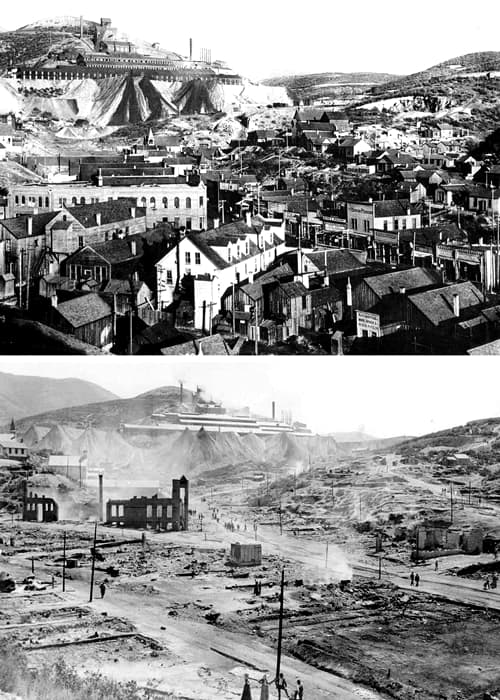
Above: Mercur, Utah before and after the 1902 fire.
After the fire, the Mercur Drug Company rebuilt the Mercur store but Luft sold his stake in the business to a Dr. Barry in 1906 and moved himself and his family to New York where he took up a position with the American Druggists’ Syndicate.
American Druggists’ Syndicate
The American Druggists’ Syndicate (ADS) was organised in New York in 1905 by Charles H. Goddard [1871-1930]. It was set up to manufacture and sell proprietary medicines and drug sundries to its members who had to agree to buy one share in ADS at $US10 each every month for nine months provided it was necessary to do so. Initially, membership was to be limited to 1,000 but this grew to nearly 25,000 by 1916.
Luft was invited to New York by Goddard who met Luft in Mercur. Goddard was a colourful character with a long history of dubious business practices. In the 1890s, before he got into mining and other syndicates, he worked in a series of newspapers. After getting into trouble in Salt Lake city, he moved to Mercur in 1895 to work for the ‘Mercur Miner’. He was still there in 1896 when he put a bullet through a showcase in the Mercur Drug Store.
Up at the Mercur drug store there are two clear-cut holes through the sides of a show-case and the shot that did it was fired Tuesday evening.
The proprietor of the store is very reticent concerning the occurrence, says the Mercur Mercury, and no definite details are obtainable from that source, but the general rumor is that C. H. Goddard went into the store durIng the absence of Mr. Luft and asked Mr. Little, who was in charge, for a drink of whisky, which was refused. Then Goddard didn’t do a thing but pull his gun and the trigger at the same time. The bullet missed Little about a foot and went crashing through the showcase.
A Mercury reporter interviewed Mr. Goddard concerning the affair and he gave an entirely different version, and while admitting that he fired the shot, claims that the gun went off accidentally. While being inclined to give him the benefit of every doubt we still feel that there are parts of his explanation which would go better with a little salt.
No arrests.(‘The Salt Lake Herald,’ Saturday, April 18, 1896, p. 3)
Goddard’s obituary in the ‘Journal of the American Pharmaceutical Association’ makes the relationship between the two men clear.
While engaged in operating a newspaper in Mercur, a mining town of Utah, Mr. Goddard made the acquaintance of George W. Luft, a retail druggist of the town. Mr. Luft was then mayor and a personage of influence, in addition to being the town druggist. At night, around the stove in the Luft drug store, were discussed drug store problems which gave Goddard the inspiration for organizing the Syndicate.
(‘Journal of the American Pharmaceutical Association,’ November, 1930, p. 1267)
Luft was employed as the Treasurer and Director of Production for ADS and also served on a number of ADS subsidiaries including the Aseptic Products Company, Vogue Chemical Company, East River Company, and Elliot Novelty Company. The experience he gained during his time with ADS in product development, production, promotion and distribution must have been invaluable.
Doriot
In addition to working with ADS it appears that Luft developed his own businesses during the 1910s. From 1917, he began selling cosmetics to the Doriot-Lenné Company based in San Fransisco under the brand name Doriot. Like many other American firms at the time, French sounding names were used to give products greater credibility, many American consumers then believing that the best cosmetics came from France. An advertorial put out by Doriot-Lenné reinforced the idea that the products came from France.
Almost ten years ago I was attracted by the name Mons. Doriot, and entered his place in Paris, and when I saw the name on his window in New York four years ago, I was delighted to feel that my personal wants could be supplied without the usual delay in ordering from Paris. But to-day, when I saw the new store at 316 O’Farrel street, I had to go in and compliment them on following the demand for their products to the very home of the users.
Mons. Doriot has always been too modest and has contented himself with supplying the larger manufacturing concerns and the big dealers with his wonderful products under their own brands, which they marketed as their own products. Luckily for Mons. Doriot, he became acquainted with the present general manager of his stores and factories through business dealings, and was soon convinced that his methods of marketing his products were wrong, or rather were not ideal. An alliance was formed, and the firm of Lenné, of Stockholm, Sweden, was absorbed into the new business and the product marketed under the name of “Doriot”—a name known wherever women desire beauty, and wherever men or women are attracted and held by the subtile odors of rare perfume oils and wonderous floral perfumes.
(Desley, 1918)
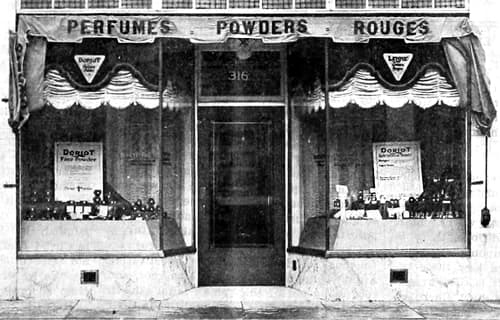
Above: 1918 Doriot-Lenné shop at 316 O’Farrell Street, San Francisco.
The Doriot product list sold by Doriot-Lenné was extensive. By 1919, it included: Doriot Muscle Oil; Cleansing Cream; Creme de Jour; Creme de Nuit; Face Powder in Old Ivory, Peach Blow, and Olivine shades; Dekltone, a liquid powder in White, Brunette, and Evening shades; Rouge, a compact rouge in De L’Alsachaine and Castillion shades; Liquid Rouge; Lipstick; Eyebrow Pencils; Shampoo; Brilliantine; Talcum; and Bath Salts.
Mons. Doriot
In 1920, Luft resigned from the ADS and established the George W. Luft Company, Inc. with the assistance of two investors, J. A. Trimble and R. A. Barton. Based at 181 Eighth Street, Long Island City, the company was formed to produced pharmaceuticals and cosmetics all sold under the Mons. Doriot trade name.

Above: Mons Doriot trademark which the George W. Luft Company claimed it had first used in 1921.
The trademark filed by Luft is similar to an earlier one filed by the United Sales Syndicate of San Francisco.

Above: Doriot trademark the United Sales Syndicate claimed it had first used in 1917.
This Doriot design appears in the shop window of Doriot-Lenné so there is clearly a link between George Luft, Doriot-Lenné and the United Sales Syndicate which suggests that the mysterious Monsieur Doriot was actually George Luft. I also wonder if Luft had plans to make the United Sales Syndicate an organisation similar to ADS but operating from the West Coast. Whatever his intentions, these would change with the success of Tangee.
Tangee
Amongst the Mons. Doriot products sold by George W. Luft was a tangerine-coloured lipstick made with a fluorescein dye (bromo acid). Bromo acid dyes are characterised as ‘changeable’; the one Luft used was tangerine in colour but turned red when the lipstick was applied to the skin.
See also: Indelible Lipsticks
Originally sold under the Mons. Doriot label, Luft claims to have used the Tangee name ‘since about 1920’ but it was not until 1923 that it became prominent. Initially, the lipstick was suggested for the cheeks and lips but Luft had added cream and compact rouges to his advertisements by 1924.
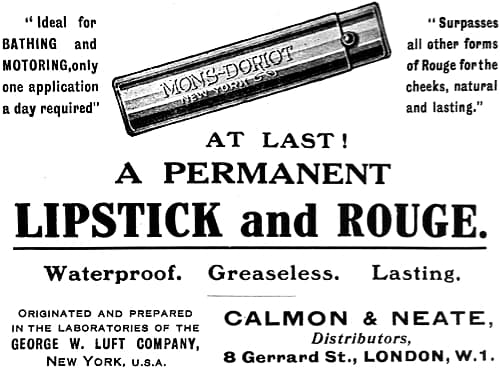
Above: 1923 Mons. Doriot Lipstick and Rouge (Britain).
Tangee Lipstick: “[S]unset orange that changes to blush-rose as it touches your lips. A cold cream base gives it firmness, extraordinarily natural effects in shading, and five times the usual lipstick’s life.”
Tangee Crême Rouge: “[G]reaseless, marvelous for blending, perfect in tone for blonde or brunette, because like the lipstick it changes color to blend with your complexion.”
Tangee Rouge Compact: “[A] little friend in need for your purse—to use for that added bit of color when you go from daylight to artificial light.”
In 1926, when Tangee lipsticks and rouges proved to be highly successful, Luft turned them into a range by adding three new cosmetics – Tangee Night Cream (a cold cream), Day Cream (a vanishing cream) and Face Powder with all traces of Mons. Doriot left off the new packaging.
Tangee Night Cream: “A bit to cleanse the skin, smoothed on rubbed off. A bit to nourish, patted in lightly and left on.”
Tangee Day Cream: “[P]rotects your complexion during the day—keeps you nose from getting shiny—and makes a perfect base for powder.”
Tangee Face Powder: “To ensure that cool flower-petal perfection that gives the final touch of attractiveness—and lasts all day.” Shades: Peach Blow, Rose, Cream, Rachel, and White.
See also: Cold Creams and Vanishing Creams
By the late 1920s the Tangee line had become the mainstay of the company’s fortunes and Luft had organised the six products in the Tangee Beauty Set into a beauty routine.
To Prepare the Way
Begin using Tangee Night Cream tonight. A bit to cleanse. A bit to nourish . . . It will quickly improve and refine the texture of your skin—and so give you the “first step to loveliness” . . . But look for the name “Tangee”; most nourishing creams don’t cleanse.For True Texture—And No Shiny Nose!
Start with Tangee Day Cream tomorrow—the perfect base for powder—soft and white as snow, delicately perfumed . . . and you’ll achieve the “second step to loveliness” . . . The name “Tangee” on every jar protects you from too heavy creams that clog the pores.For Youth’s Own Glow
Spread on the tiniest dab of Tangee Crême Rouge—and see it change color, like magic, as it touches your skin—from orange to blush-rose—and the shade blends with YOU! For Tangee rouge changes color as it goes on to blend with every complexion—blonde or brunette—and is permanent and waterproof.And Versatility
Little things like going from sunlight to artificial light, putting on your hat, or taking it off—they make alterations in youth’s vividness you may copy, if you have Tangee Rouge Compact—with you! . . . It’s the same color magic in caked powder form, with convenient puff and mirror.For Flower-Petal Perfection
You need a powder that’s so fine, so fluffy, so clinging that it smooths and perfects the texture of your skin without itself being detected—Tangee Face Powder! In the five true shades: Peachblow, Rose, Cream, Rachel and White—packed so you can see the shade.And Irresistible Lips
Tangee Lipstick, the last and most important step to loveliness—color magic that changes from orange to blush-rose as it touches your lips—a Sorcerer’s wand that gives you Nature’s glow of youth—the final touch of glamour we all most need . . . And it’s waterproof and lasts all day!(Tangee advertisement, 1927)
The concentration on the Tangee range did not mean the end of Mons. Doriot products and Luft continued to produce some lines under this name well into the 1930s.
There were three additions to the Tangee range through to 1930. First, Tangee Tan (1929), a new shade of face powder. Second, Tangee Theatrical (1930), a darker lipstick shade for professional or evening use, with the original Tangee Lipstick shade now referred to as Natural. Third, Tangee Cosmetic (1930), a cake mascara that did not smart, suggesting it was made with triethanolamine rather than soap.
Tangee Cosmetic: “[A] new ‘mascara’ does not smart the eyes, also used for tinting the hair.”
See also: Cake Mascara

Above: 1931 Tangee Cosmetic (mascara), Day Cream, Night Cream, Creme Rouge, Compact Rouge, and Face Powder.
1930s
There were few developments in the Tangee range during the 1930s and the company passed through an entire decade without a major product innovation only introducing new packages, shades, and formulations.
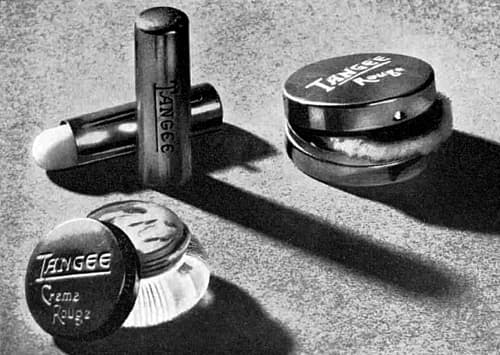
Above: 1932 Tangee Lipstick, Cream Rouge, and Compact Rouge with puff (Britain).
In 1933, the company debuted a small-sized Tangee Face Powder and Lipstick along with a rouge refill to fit all Tangee compacts, all extras designed to help maintain sales when money was tight.
The company also refreshed the packaging for Tangee cosmetics, the most dramatic being the face powder box which now came in four shades – Flesh, Rachel, Light Rachel, and White. There is evidence to suggest that Luft had reformulated the face powder by 1935 so, like the lipstick and rouge, it now contained fluorescein dyes.
You’ll find this new powder gives your skin a smooth finish without that coated, mask-like effect. Tangee does this because it contains the magic Tangee color principle. Produces a soft underglow. Makes your complexion appear younger, fresher and more natural.
(Tangee advertisement, 1935)
Despite the lack of innovation, the dire economic conditions of the 1930s was good for Tangee. Throughout most of this period Tangee Natural Lipstick was the most popular lipstick on the American market, outselling Max Factor, Coty, Lady Esther and many others. As well as being sold cheaply in 5 and 10 cent stores its use of a dye rather than a pigment meant that younger women could avoid the objections their mothers levied against more obvious lipsticks.
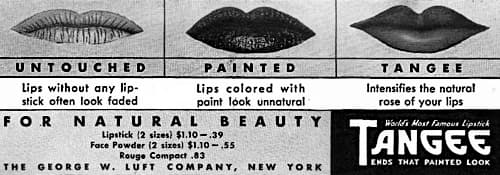
Above: 1936 Tangee advertisement.
In the 1930s, this objection to ‘paint’ was taken up by Tangee and used in a number of negative advertisements; some getting very strident.
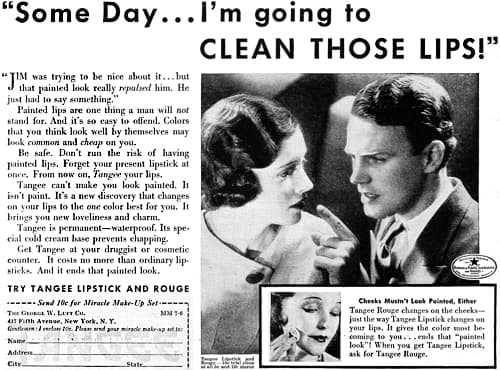
Above: 1932 Tangee advertisement.
Constance Luft
In 1939, George Luft died during an operation and his daughter, Constance Luft Hahn, was elected president of the company. She became the face of Tangee and her image frequently appears in advertisements in the 1940s.
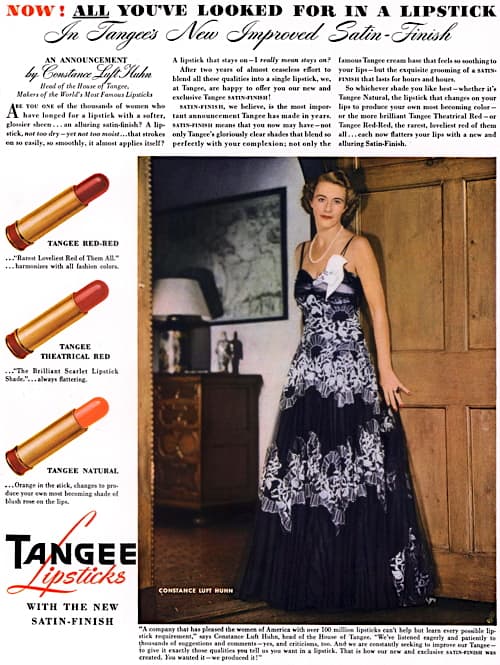
Above: 1942 Tangee Red-Red, Theatrical Red and Natural Lipsticks with Constance Luft Huhn.
By the 1940s, objections to make-up were becoming less frequent and women were looking for a larger shade ranges. The limited colour range was affecting Tangee sales. By 1942, Tangee lipsticks had fallen from first to third position in the United States behind Max Factor and Coty. This situation was to worsen as sales of Revlon lipsticks began to rise.
See also: Revlon
Starting with Red-Red in 1940, Tangee added a number of new shades including Medium-Red (1942), Gay-Red (1945), Red Majesty (1946), and Pink Queen (1948). Like Theatrical Red, these shades could only be accomplished with the addition of pigments.
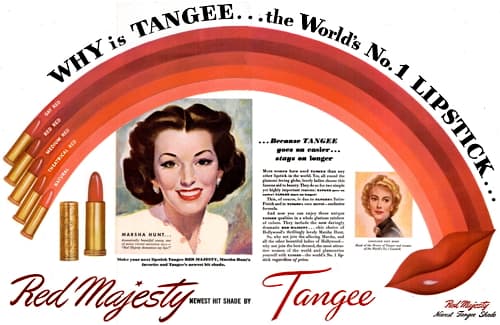
Above: 1947 Red Majesty in new twist-up cases introduced when Tangee returned to metal cases in 1946.
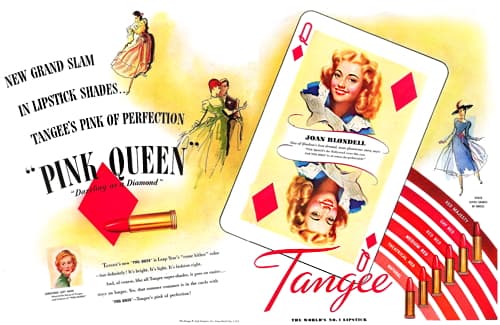
Above: 1948 Pink Queen.
The introduction of Medium-Red seems to have coincided with Tangee reformulating its lipsticks, now advertised as having a ‘Satin-Finish’.
Satin-Finish Lipstick: “[N]ot too dry, not too moist, help prevent lips cracking and chapping in cold weather.” Shades: Natural, Theatrical Red, Red-Red, and Medium-Red.
Satin-Finish Lipsticks were complemented with a new Petal-Finish Cream Rouge (1942) in the same shades. Then, in 1943, Tangee introduced Petal-Finish Face Powder.
Petal-Finish Face Powder: “[R]eally does give your complexion a velvet-soft, radiant rose-petal finish that stays . . . and stays . . . and stays!“ Shades: Natural, Peach, Light Rachel, Rachel, Dark Rachel, and Tan.
Additional Petal-finish items were Tangee Petal-Finish Cake Make-up (1944) in a pink compact, and Tangee Petal-Finish Pressed Powder (1951). Both came in the same shades as the Petal-Finish Face Powder. Like other cake make-ups, Petal-Finish was applied with a moist sponge, while the pressed powder used a puff.
Petal-Finish Cake Make-up: “[I]s so very easy to apply . . . stays on for so many extra hours . . . is designed to be oh-so-kind to your skin! And you don’t look—or feel—as if you were wearing a mask.” Shades: Natural, Peach, Light Rachel, Rachel, Dark Rachel, and Tan.
Petal-Finish Pressed Powder: “Can be used as a powder base or over regular foundation. Conceals tiny blemishes and gives the skin a smooth glowing matt finish.” Shades: Natural, Peach, Light Rachel, Rachel, Dark Rachel, and Tan.

Above: 1953 Constance Luft watching Tangee Lipsticks being made.
In 1952, Tangee added a liquid foundation called The Miracle Make-Up to its range. The company had used the term Miracle before, selling Miracle Make-up sets in the 1930s. Unlike the earlier Petal-Finish lines this new product came with its own shade range.
The Miracle Make-Up: “[L]ets your skin breath—never clogs pores—never cakes, cracks or dries out! Perfect for oily or dry skin, never mask-like or greasy . . . and it lasts!” Shades: Rosey Touch, Light Blush, Cream Beige, Cameo Pink, Cream Tone, and Sun Dream.
Lipstick Wars
In 1950, Hazel Bishop began a national campaign to sell its Long Lasting Lipstick, setting off what became known as the ‘Lipstick Wars’ in the United States.
See also: Lipstick Wars
While Luft was not a major player in this battle for dominance in the lipstick market, the company clearly felt that its Tangee lipsticks were under threat from Hazel Bishop as they were aimed at the same market.

Above: 1947 Tangee Beauti-Set – Tangee Lipstick Rouge and Face Powder in pink containers – sold through Woolworths.
Hazel Bishops’ Lasting Lipstick was an indelible. In 1951, to counter this, Luft began advertising that its Tangee Lipsticks, which had been reformulated in 1950, now contained ‘Permachrome’ giving them an improved indelibility.
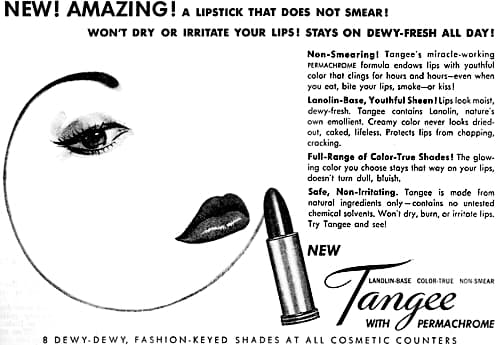
Above: 1952 Tangee Lipsticks with Permachrome. The image used takes its inspiration from the January, 1950 cover of American Vogue.
The advertising copy for these Permachrome lipsticks also tried to counter Hazel Bishop’s highly effective “won’t eat off, bite off or kiss off” tag-line.
A lanolin-base, non-smear lipstick that won’t dry your lips, stays dewy-fresh all day long. The first and only non-smear lipstick that endows your lips with a youthful, creamy sheen . . . comes in a wide range of glowing colors! And it won’t smear off! Once applied it clings to your lips all day long . . . keeps them dewy-fresh looking even when you eat, smoke, bite your lips . . . or kiss! And the reason for this cosmetic miracle . . . Tangee’s amazing new scientifically balanced Permachrome formula.
Tangee advertisement, 1952)
In addition to Permachrome, Tangee introduced a number of new lipstick shades in the early 1950s including Pretty Please (1950), Rhapsody in Pink (1952), Bright ’n Clear (1954), and Busy Number (1955).

Above: 1956 Tangee Busy Number.
Luft also belatedly added Tangee Liquid Rouge (1955) following Hazel Bishop’s Complexion Glow introduced in 1952.
Tangee Liquid Rouge: “[N]ever looks ‘plastered.’ Instead, it gives your complexion a truly natural bloom of radiant color that stays on all day long!” Shades: Natural, Theatrical Red, Medium-Red, Red-Red, and Pink Queen with Rhaspsody in Pink, Red Majesty, Pretty Please, Gay Red, and Bright ’n Clear added in 1956.
Hazel Bishop got into financial difficulties after 1955 and no longer posed a threat to the majors like Revlon and Coty but it still competed in the same commercial space as Tangee.
See also: Hazel Bishop
As American lipstick fashions moved away from indelible to creamy forms in the second half of the 1950s, Tangee introduced Living Colors containing yet another trademarked ingredient ‘Lanalure’ which sounds like it was a form of lanolin, commonly added to make lipsticks creamy. Living Colours lipsticks came in the same 10 shades as earlier forms but this time the advertising copy seems to have taken Coty’s “24” lipstick “Wake up beautiful with ‘alive’ color glowing on your lips!” tag as its model.
Exclusive Lanalure keeps Tangee’ brilliant Living Colors alive on your lips—glowing without a shadow of greasiness, all day long! Lanalure keeps you lips soft, moist, and lustrous—prevents drying and cracking!
(Tangee advertisement, 1955)
One interesting feature of these lipsticks was that Tangee made them in four price points for the American market.
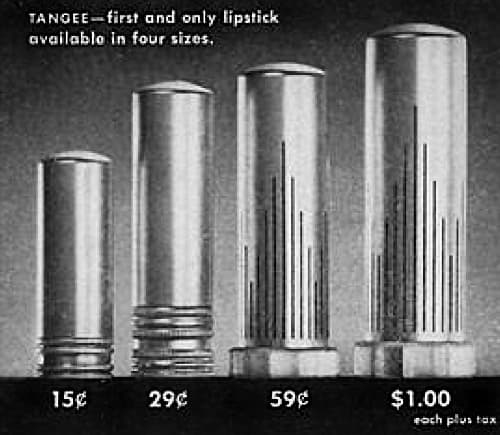
Above: 1955 Tangee Living Color Lipsticks in four sizes.
Tangee was primarily a make-up range but Luft introduced two lip and skin-care lines in 1954 – Chap-Away Lip Pomade, and Tangee Fluid Beauty, a moisturiser.
Chap-Away was similar to ChapStick. It contained 2-ethyl-hexyl salicylate which acted as sunscreen as well as thymol and camphor.
Chap-Away: “Soothes dry, chapped lips; helps protect them from wind or sun.”
Fluid Beauty was a non-greasy, non-sticky emollient lotion that Tangee suggested could be used as a moisturiser on the face, hands and elbows.
Tangee Fluid Beauty: “[G]ives skin instant smoothness without greasiness and it works while you sleep! With your first application wrinkles seem to disappear . . . lines and cracks almost vanish before your eyes! Your skin looks healthier, lovelier . . . feels smoother than ever!”
Tangee added a number of other lipstick shades through to the end of the decade including Rich ’n Red, Coral Please, Tropicana Orange, Pink Ballet, Light ’n Pink, and Sunkissed Peach but had long since lost its first position in lipstick sales. Unlike Hazel Bishop, Tangee did not add matching nail polishes until 1960. This was a major failing, with most cosmetic companies realising long before this that they needed a nail polish in their range to maintain sales of their lipsticks.
When introduced, Tangee Nail Polish consisted of 8 regular shades and 5 iridescent shades. It was advertised as containing ‘Protogel’, said to help nail growth and assist the polish in resisting chipping and splitting.
Later developments
In 1955, Constance Luft stepped down as the company president and became chairman of the board. I do not know if this was voluntary or if she was ‘pushed’. Her position as president and chief executive officer was taken over by John A. Cawley who was brought in from outside the company.
The Tangee range continued on through the 1960s but was eventually sold to A.R. Winarick, Inc. in 1971. The new owners appear to have abandoned it by 1980. At some stage it was picked up by The Vermont Country Store, Vermont and they sell a modern formulation of Tangee Natural Lipstick along with a few other Tangee lines.
Timeline
| 1920 | George W. Luft Company, Inc. founded in New York. International Cosmetic Company founded. |
| 1921 | New Products: Mons. Doriot range. |
| 1926 | New Products: Tangee Night Cream; Tangee Day Cream; and Tangee Face Powder. |
| 1930 | New Products: Tangee Cosmetic (mascara). |
| 1932 | Luft-Tangee Ltd. founded in London. |
| 1935 | New London sales office opened at 88 Regent Street. |
| 1938 | Luft-Tangee (Canada) Ltd. incorporates. |
| 1942 | New Products: Satin-Finish Lipstick; and Petal-Finish Rouge. |
| 1943 | New Products: Petal-Finish Face Powder. |
| 1944 | New Products: Petal-Finish Cake Make-up. |
| 1949 | New Products: The Glamourizer. |
| 1951 | New Products: Petal-Finish Pressed Powder. |
| 1952 | New Products: Miracle Make-Up. |
| 1954 | New Products: Chap-Away Lip Pomade; and Tangee Fluid Beauty. |
| 1956 | New Products: Tangee Liquid Rouge. |
| 1960 | New Products: Tangee Nail Polish. |
| 1971 | Luft Cosmetics acquired by A.R. Winarick, Inc. |
First Posted: 24th February 2021
Last Update: 7th March 2021
Sources
The American Perfumer & Essential Oil Review. (1906-1955). New York: Robbins Perfumer Co. [etc.].
Desleys, V. (1918) Mons. Doriot Shop. The Wasp, Saturday, March 16, 9.

George William Luft [1869-1939].

1919 Doriot-Lenné cosmetics.

1922 Mons. Doriot Tangerine Rouge.
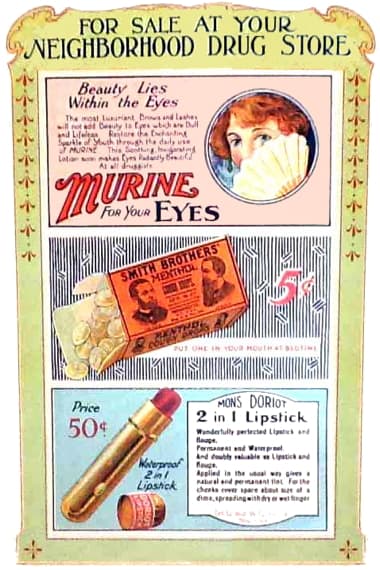
1923 Mons. Doriot 2 in 1 Lipstick.
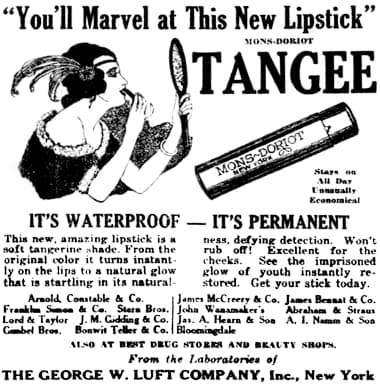
1923 Mons. Doriot Tangee Lipstick.
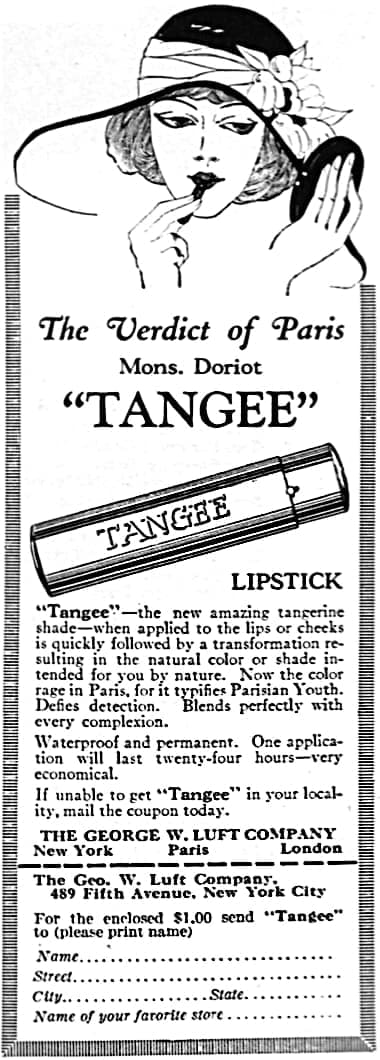
1923 Tangee Lipstick.
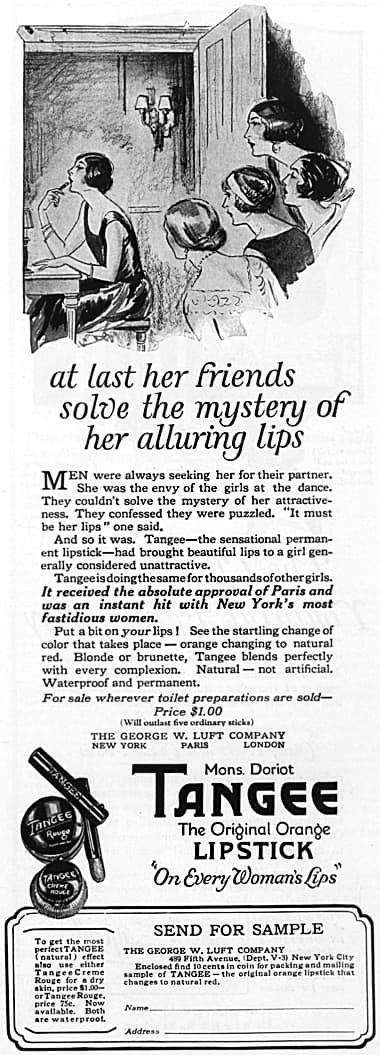
1924 Tangee Lipstick and Rouge.
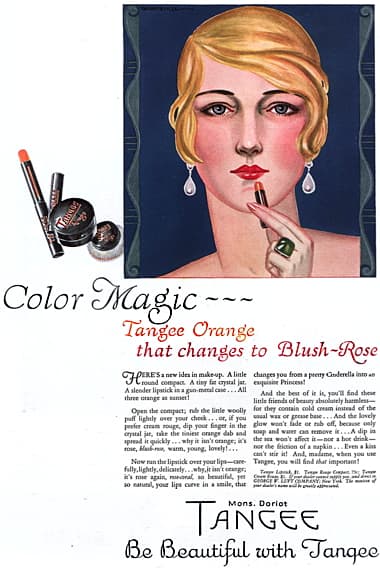
1925 Tangee Lipstick, Creme and Compact Rouge.

1926 Tangee.

The small extension to the building on the left is 417 Fifth Avenue New York. Luft had settled here by 1926.

1927 Tangee Beauty Aids.
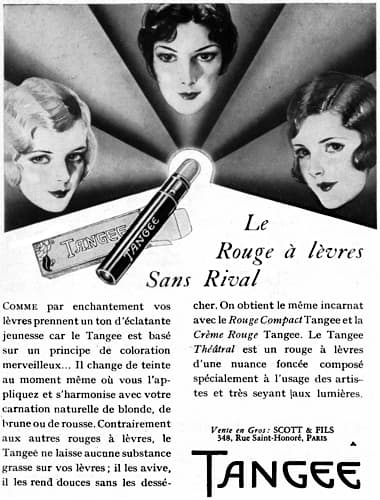
1931 Tangee (France).
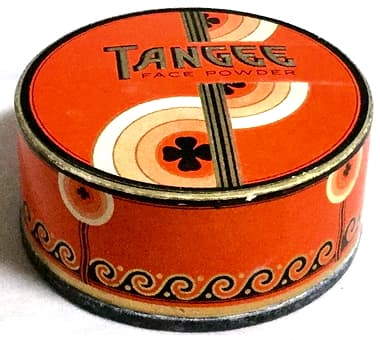
Tangee Face Powder box introduced in 1933.

1935 Tangee Face Powder (Britain).

1936 Tangee 24-Hour Miracle Make-up Set.

1938 Tangee.
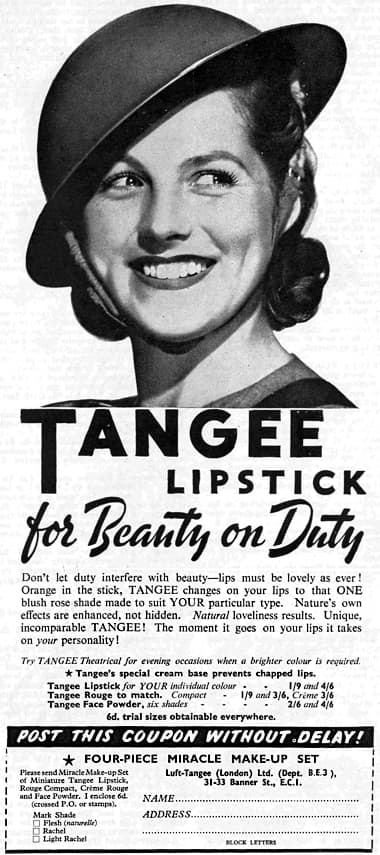
1939 Tangee ‘Beauty is a Duty’ (Britain). Tangee trademarked this tagline.

Constance Luft Huhn [1902-1982].
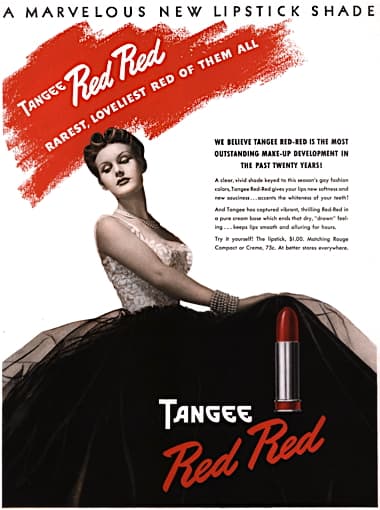
1940 Tangee Red-Red.
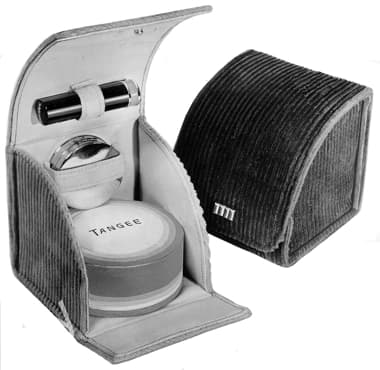
1940 Tangee Tuckaway containing Tangee Lipstick, Compact Rouge, and Face Powder. Available in Air-Force Blue, Tawny Tan, and Vivid Red.

1943 Tangee Petal-Finish Face Powder in the box introduced in 1940.
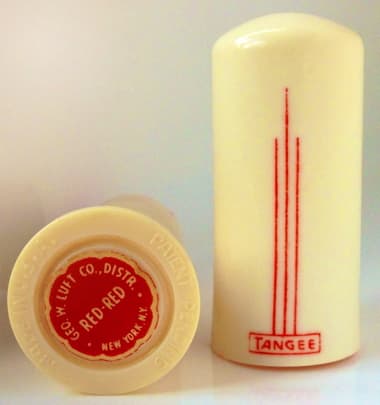
1943 Tangee Lipstick. One of a number of plastic cases introduced by Tangee during the war.

1943 Tangee War, Women and Lipsticks.

1944 Tangee Lipstick, Face Powder and Rouge (South America).
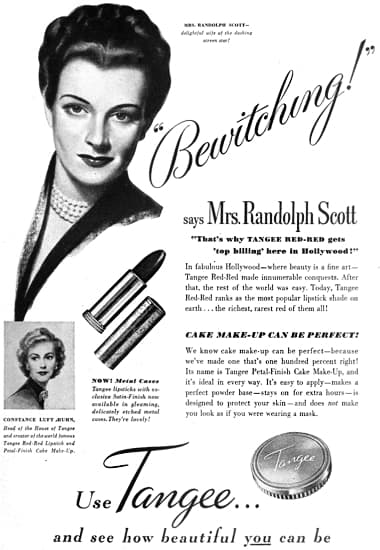
1946 Tangee Satin-Finish Lipstick in an etched brass, gold-plated case, and Petal-Finish Cake Make-up.
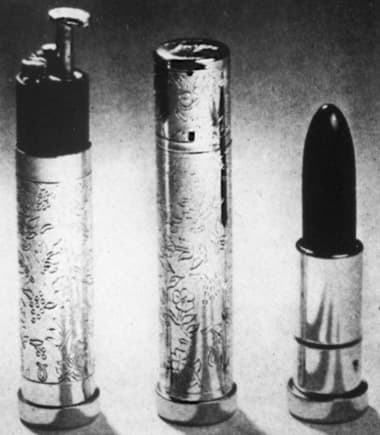
1949 Tangee Glamourizer, a combination lipstick and perfume atomiser in an embossed gold-plated case similar to the one used for lipsticks.
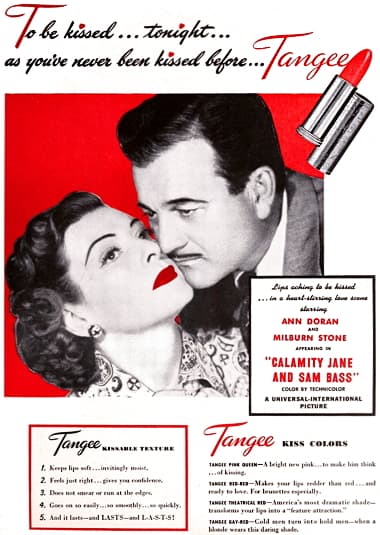
1949 Tangee Pink Queen, Red-Red, Theatrical Red, and Gay-Red Lipsticks.

1953 Tangee Lipstick and Miracle Make-up.
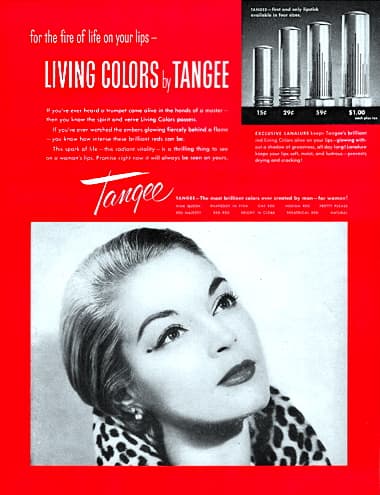
1955 Tangee Living Colors Lipsticks.
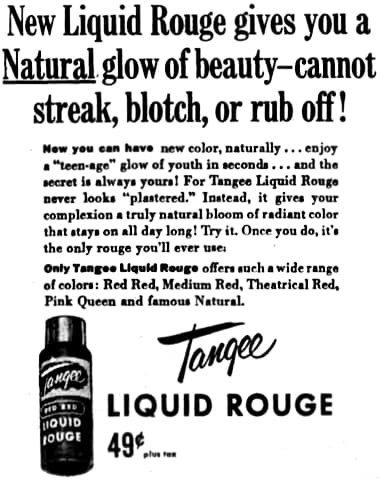
1955 Tangee Liquid Rouge.

1958 Tangee Natural Lipstick.
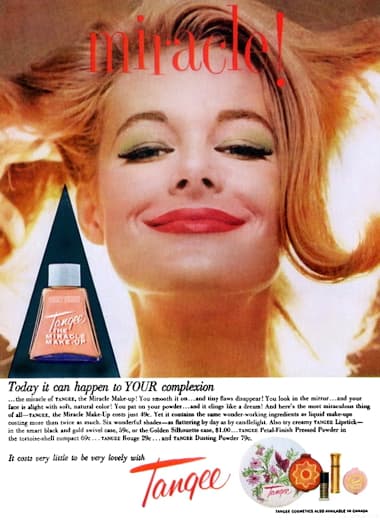
1959 Tangee Dusting Powder, The Miracle Make-Up, Petal-Finish Pressed Powder, Lipsticks, and Rouge.
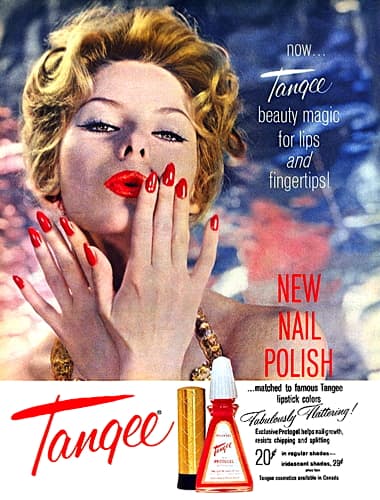
1960 Tangee Nail Polish.
